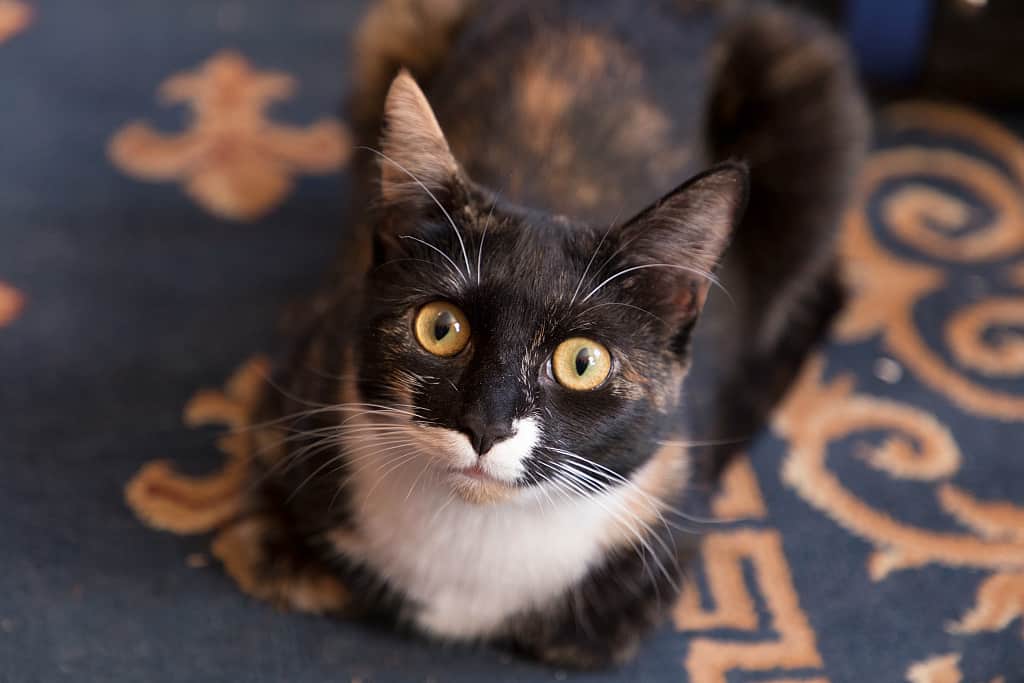The unicorn of cats, despite wishing thinking, is not a cat with a single horn on their head. The “unicorn of cats” is a nickname for a male tortoiseshell or calico cat because of how rare they are.
Females cats have two X chromosomes and male cats have one X and one Y chromosome. Since the genes expressed on both X chromosomes are linked to the coat pattern in tricolor cats like tortoiseshells and calicoes, these cats are virtually always female.
How rare is the male calico or tortoiseshell cat?
The likelihood of a tortoiseshell cat being male is 1 out of 3,000. This means that about 0.03% of tortoiseshell cats are male.
A survey of veterinary practices in the United Kingdom found that out of 4,598 male cats only 20 were tortoiseshells. [1] This calculated out to a rate of 0.43% of cats being male tortoiseshells.

When can calico and tortoiseshell cats be male?
For a long time, researchers were perplexed about why tortoiseshell cats were rarely male. There were many hypotheses bandied about trying to explain this phenomenon. [2]
Scientists now understand that chromosome variations can produce instances where a male cat can have a tortoiseshell fur coat pattern.
Abnormalities in chromosome karyotype and male tortoiseshell cats
When a tortoiseshell or calico cat is male, it is because of abnormalities in chromosome karyotype. These male tortoiseshell cats have an extra X chromosome. This means these male tortoiseshells have three chromosomes (XXY) instead of two (XY).
Male tortoiseshell and calico cats are almost always sterile due to these three chromosomes.
Chimera and fertile male tortoiseshell and calico cats
There have been a few instances of fertile male tortoiseshells but they are incredibly rare and linked to chimera. [3]
A study published in 2020 that analyzed the genetic of a fertile male Maine coon cat with tortoiseshell coloring. Cytogenetic analysis showed that the male had two chromosomes XY. Further DNA analysis of samples taken from the blood, hair roots, and testicles revealed that the cat was a chimera. [4]
Chimera in cats happens when two embryos fuse together to form one kitten. For males this results in 38,XY/38,XY as cats have 19 chromosome pairs, 18 autosomes and the sex chromosome pair. With two X chromosomes, chimera male cats can have a tortoiseshell or calico coat pattern and still be fertile.
Video: What is the “Unicorn of cats”
References
[1] Leaman, T., Rowland, R., & Long, S. E. (1999). Male tortoiseshell cats in the United Kingdom. Veterinary record, 144(1), 9-12. https://doi.org/10.1136/vr.144.1.9
[2] Bamber, R. C. (1922). The male tortoiseshell cat. Journal of Genetics, 12(2), 209-216.
and
Jones, T. C. (1969). Anomalies of sex chromosomes in tortoiseshell male cats. In Comparative mammalian cytogenetics (pp. 414-433). Springer, Berlin, Heidelberg.
[3] Jude, A. C., & Searle, A. G. (1957). A fertile tortoiseshell tomcat. Nature, 179(4569), 1087-1088.
[4] Bugno‐Poniewierska, M., Kij, B., Witarski, W., Wojtaszek, M., Radko, A., Podbielska, A., … & Murphy, W. J. (2020). Fertile male tortoiseshell cat with true chimerism 38, XY/38, XY. Reproduction in Domestic Animals, 55(9), 1139-1144. https://doi.org/10.1111/rda.13752






